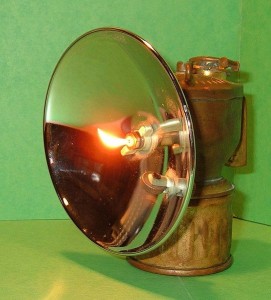Ms. Wilson’s chemistry class is looking at basic chemical reactions, and today they got to fire an acetylene cannon. When calcium carbide (CaC2) reacts with water (H2O) they produce acetylene (C2H2), which is quite explosive.
CaC2 + 2 H2O → C2H2 + Ca(OH)2
Acetylene is so flammable, because its carbons are held together by a triple bond: when the triple bond breaks it releases a lot of energy (about 839 kJ per mole).
Table 1: Bond strengths of simple hydrocarbons with carbon to carbon bonds
| Name | Chemical Formula | Diagram | Carbon to Carbon Bond Strength (kJ/mol) |
|---|---|---|---|
| Acetylene | C2H2 |  |
839 |
| Ethene | C2H4 |  |
611 |
| Ethane | C2H6 |  |
347 |
The explosion is a result of the combustion of the acetylene:
2C2H2 + 5O2 –> 2H2O + 4CO2
And this whole process — carbide plus water to give acetylene, which is then burned — was used by miners in the early 20th century to make headlamps (among other types of lamps).

The cannon itself is a simple device, made of a 50cm tube of 2-3 inch diameter PVC (sorry about the mixed units), with a screw cap at one end. The carbide grains (about 0.5 g) are placed on the inside of the cap, which is then screwed on to the bottom of the tube. A few drops of water are then added through a small hole in the PVC using a plastic dropper — you can listen for the sizzling to tell if the carbide decomposition reaction is happening. Finally a flame is applied to the same hole as the water. The sock, by the way, is just lightly tucked in near the top of the PVC tube, about 5 cm in.
The explosion was loud, and Ms. Wilson’s sock traveled about 10 meters. It was suitably impressive. I think the student who was the most impressed was the one who had weighed out the calcium carbide, becaues 0.5 grams is really only four or five grains.
